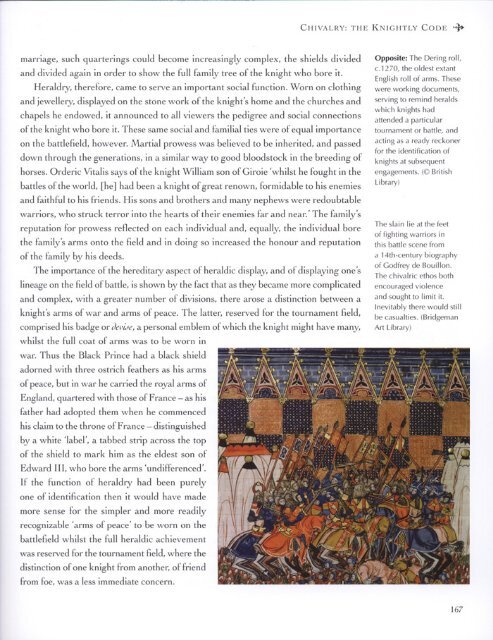Osprey - General Military - Knight - The Warrior and ... - Brego-weard
Osprey - General Military - Knight - The Warrior and ... - Brego-weard
Osprey - General Military - Knight - The Warrior and ... - Brego-weard
You also want an ePaper? Increase the reach of your titles
YUMPU automatically turns print PDFs into web optimized ePapers that Google loves.
marriage, such quarterings could become increasingly complex, the shields divided<br />
<strong>and</strong> divided again in order to show the full family tree of the knight who bore it.<br />
Heraldry, therefore, came to serve an important social function. Worn on clothing<br />
<strong>and</strong> jewellery, displayed on the stone work of the knight's home <strong>and</strong> the churches <strong>and</strong><br />
chapels he endowed, it announced to all viewers the pedigree <strong>and</strong> social connections<br />
of the knight who bore it. <strong>The</strong>se same social <strong>and</strong> familial ties were of equal importance<br />
on the battlefield, however. Martial prowess was believed to be inherited, <strong>and</strong> passed<br />
down through the generations, in a similar way to good bloodstock in the breeding of<br />
horses. Orderic Vitalis says of the knight William son of Giroie 'whilst he fought in the<br />
battles of the world, [he] had been a knight of great renown, formidable to his enemies<br />
<strong>and</strong> faithful to his friends. His sons <strong>and</strong> brothers <strong>and</strong> many nephews were redoubtable<br />
warriors, who struck terror into the hearts ol their enemies far <strong>and</strong> near.' <strong>The</strong> family's<br />
reputation for prowess reflected on each individual <strong>and</strong>, equally the individual bore<br />
the family's arms onto the field <strong>and</strong> in doing so increased the honour <strong>and</strong> reputation<br />
of the family by his deeds.<br />
<strong>The</strong> importance of the hereditary aspect of heraldic display, <strong>and</strong> of displaying one's<br />
lineage on the field of battle, is shown by the fact that as they became more complicated<br />
<strong>and</strong> complex, with a greater number of divisions, there arose a distinction between a<br />
knight's arms of war <strong>and</strong> arms of peace. <strong>The</strong> latter, reserved for the tournament field,<br />
comprised his badge or devise, a personal emblem of which the knight might have many,<br />
whilst the full coat of arms was to be worn in<br />
war. Thus the Black Prince had a black shield<br />
adorned with three ostrich feathers as his arms<br />
of peace, but in war he carried the royal arms of<br />
Engl<strong>and</strong>, quartered with those of France — as his<br />
father had adopted them when he commenced<br />
his claim to the throne of France - distinguished<br />
by a white 'label', a tabbed strip across the top<br />
of the shield to mark him as the eldest son of<br />
Edward III, who bore the arms 'undifferenced'.<br />
II the function of heraldry had been purely<br />
one of identification then it would have made<br />
more sense lor the simpler <strong>and</strong> more readily<br />
recognizable 'arms of peace' to be worn on the<br />
battlefield whilst the full heraldic achievement<br />
was reserved for the tournament field, where the<br />
distinction of one knight from another, of friend<br />
from foe, was a less immediate concern.<br />
CHIVALRY: THE KNIGHTLY CODE -







